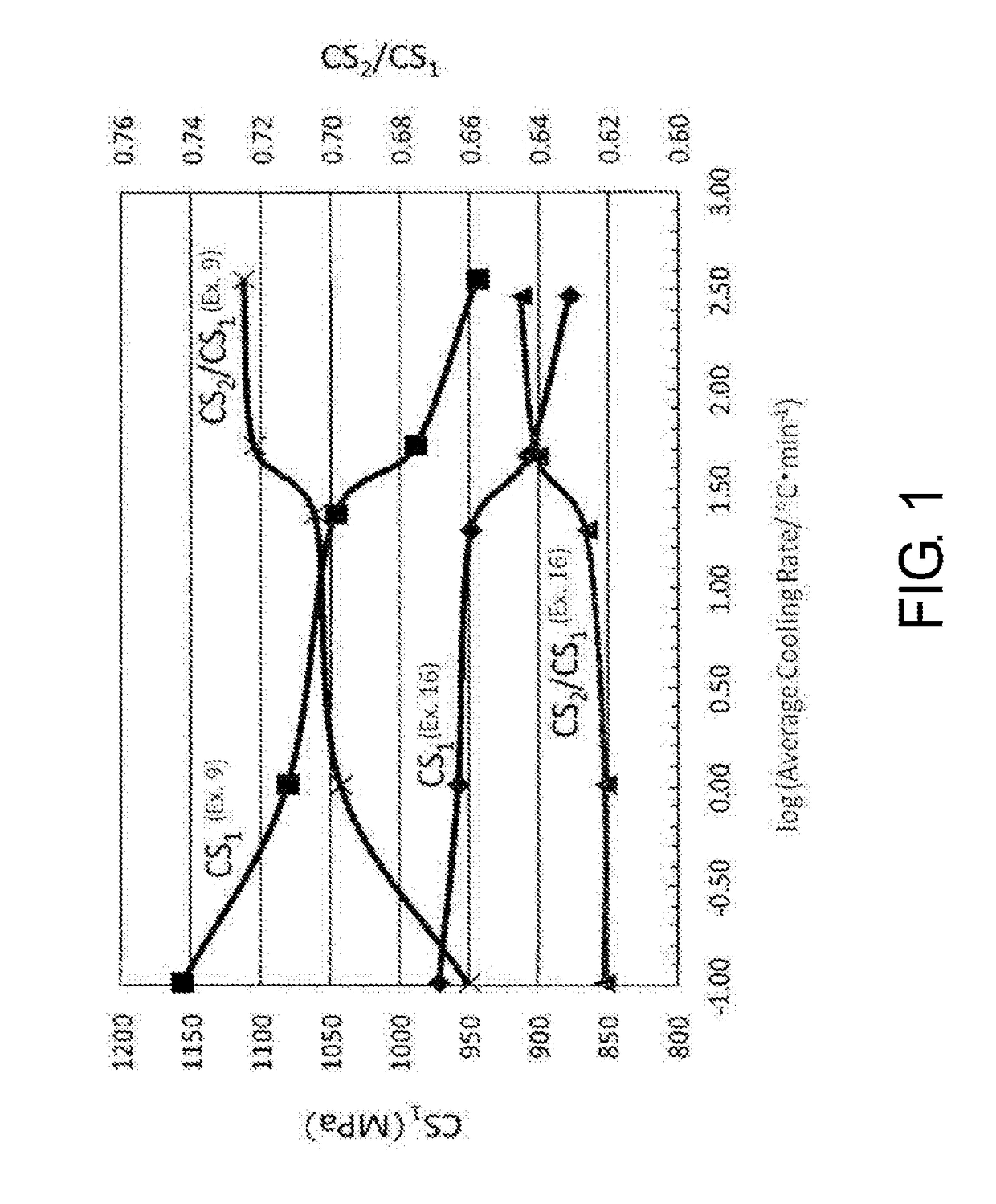Glass and chemically strengthened glass
a technology of chemical strengthening and glass, applied in the field of glass and a chemically strengthened glass, can solve the problems of difficult formation of compressive stress layer, inability to obtain the desired property of high strength, broken glass itself, etc., and achieve high surface compressive stress, suppress the effect of the reduction ratio of surface compressive stress
- Summary
- Abstract
- Description
- Claims
- Application Information
AI Technical Summary
Benefits of technology
Problems solved by technology
Method used
Image
Examples
examples
[0067]In the following descriptions, the present invention will be described in more detail, based on examples and comparative examples.
experiment 1
[0068](Producing of Glass)
[0069]Regarding Examples 1 to 19 shown in Tables 1 to 4, raw materials of each of the components were mixed so as to obtain a composition shown in columns from SiO2 to BaO as represented by mol %, and then melted at a temperature of from 1,550 to 1,650° C. with a platinum crucible for 3 to 5 hours. When being melted, a platinum stirrer was inserted into molten glass and stirring was performed for 2 hours. Thereby, the glass was homogenized.
[0070]The obtained molten glass was cast into a mold material to form a sheet shape, and was retained at a temperature of Tg+50° C. for 1 hour. Then, it was one cooled to room temperature at a cooling rate of 0.5° C. / min to obtain a glass block. The glass block was cut, polished, and finally and finally, both surfaces thereof were finished to mirror surfaces to obtain a sheet glass having a size of 2.0 mm×2.0 mm and a thickness of 0.7 mm. The obtained sheet glass was put into a mesh-belt type continuous furnace (manufactu...
experiment 2
[0091]A chemically strengthened glass was produced in a manner similar to the producing procedures of the chemically strengthened glass in Example 9 except that the average cooling rate of the glass during annealing was changed to 0.1° C. / min, 1° C. / min, 23° C. / min, 51° C. / min, or 350° C. / min. A chemically strengthened glass was produced in a manner similar to the producing procedures of the chemically strengthened glass in Example 16 except that the average cooling rate of the glass during annealing was changed to 0.1° C. / min, 1° C. / min, 23° C. / min, 51° C. / min, or 350° C. / min.
[0092]For each of the produced glasses, CS1, DOLT, CS2, and CS2 / CS1 were measured or calculated in a manner similar to that in Experiment 1. Results are shown in Table 5.
[0093]A definition method of the reaching fictive temperature of each glass will be described. When the heat treatment is performed at a certain temperature until the glass is in a thermodynamically equilibrium state and the glass is quenched ...
PUM
| Property | Measurement | Unit |
|---|---|---|
| temperature | aaaaa | aaaaa |
| viscosity | aaaaa | aaaaa |
| temperature | aaaaa | aaaaa |
Abstract
Description
Claims
Application Information
 Login to View More
Login to View More - R&D
- Intellectual Property
- Life Sciences
- Materials
- Tech Scout
- Unparalleled Data Quality
- Higher Quality Content
- 60% Fewer Hallucinations
Browse by: Latest US Patents, China's latest patents, Technical Efficacy Thesaurus, Application Domain, Technology Topic, Popular Technical Reports.
© 2025 PatSnap. All rights reserved.Legal|Privacy policy|Modern Slavery Act Transparency Statement|Sitemap|About US| Contact US: help@patsnap.com


